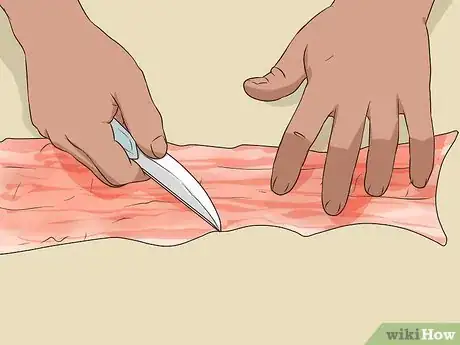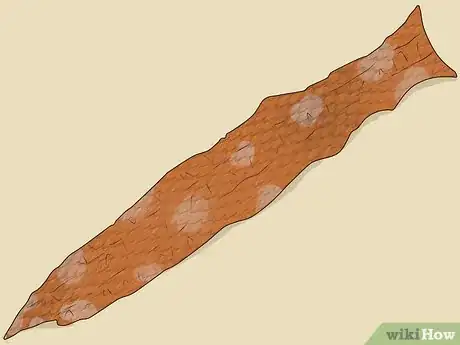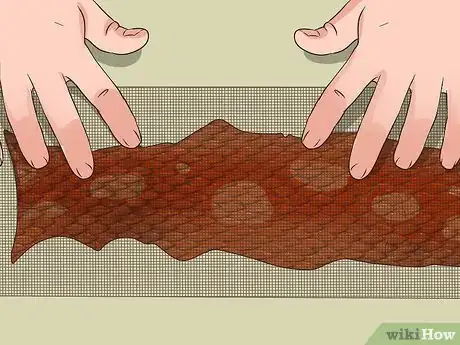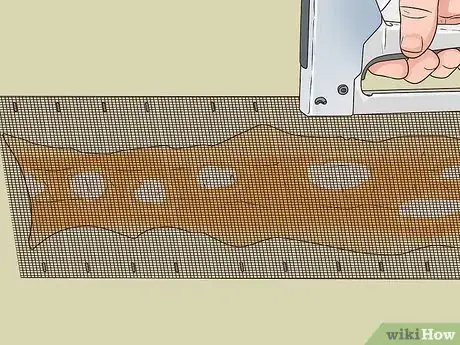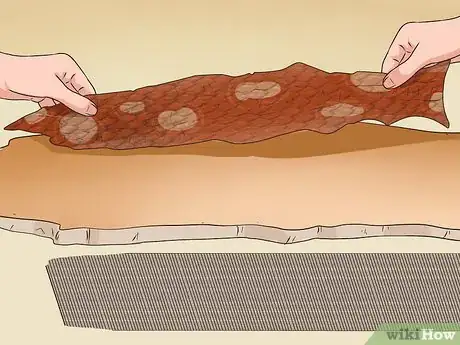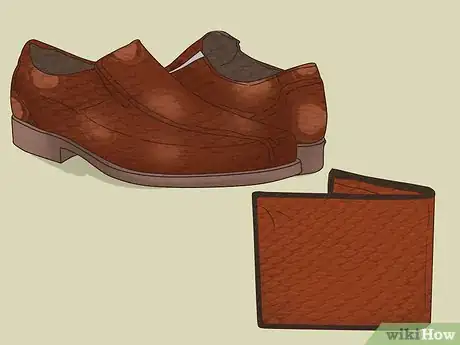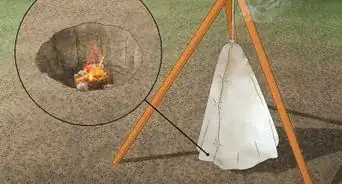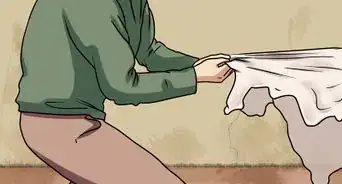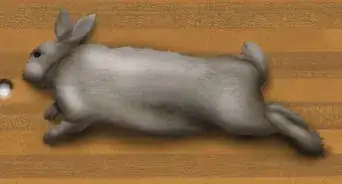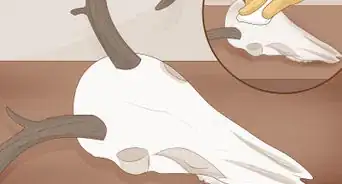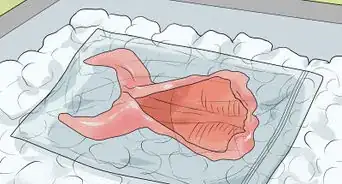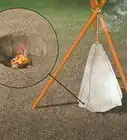This article was co-authored by wikiHow Staff. Our trained team of editors and researchers validate articles for accuracy and comprehensiveness. wikiHow's Content Management Team carefully monitors the work from our editorial staff to ensure that each article is backed by trusted research and meets our high quality standards.
This article has been viewed 206,882 times.
Learn more...
While traditional tanning is the most effective method when it comes to preserving snakeskins, drying can make a quick and easy alternative when that’s not an option. After removing any remaining tissue from the snakeskin, tack it to a flat surface and flatten with a screen, then allow it to dry naturally for up to three days. When properly preserved, snakeskins can be used as a leather-like fabric for clothing, boots, wallets and other accessories, or for a simple yet eye-catching decoration.
Steps
Stripping the Snakeskin
-
1Start with a fresh skin. Before you can cure a snakeskin, it needs to have already been removed from the snake in one piece. Make sure you take the necessary safety precautions when working with skinning tools, such as knives and calipers, and with intact specimens.[1]
- A pair of rugged work gloves will keep your hands clean and protect you from mishaps.
- Even a dead snake can be dangerous if handled improperly.
-
2Remove any remaining tissue from the snakeskin. Use the edge of a knife to slice or scrape away excess flesh and connective tissue. For best results, rest the blade at a 45 degree angle against the inner membrane and drag it along slowly to loosen whatever's stuck on it. Be careful not to use too much force, or you may damage the delicate scales.[2]
- A knife with a slightly dulled edge may work better than one that’s overly sharp, like an X-acto knife or razor blade.
- There’s no need to strip every last piece of tissue you encounter. The little bit that’s left can be peeled off with ease once the snakeskin has been dried.
Advertisement -
3Lay the snakeskin flat on an appropriate drying surface. Whatever surface you choose should be large enough to unfurl the entire length of the skin. It should also be completely level and soft enough to pierce with staples or pushpins, which you’ll use to fasten the skin and ensure that it dries flat.
- Depending on the size of the snake you’re working with and the place where you’re doing your drying, you might use a cutting board, a sheet of plywood or even a scrap of cardboard.
Pinning down the Snakeskin
-
1Flatten the snakeskin by hand. Stretch the skin out on the drying surface scale-side down and use both hands to gently smooth the curled edges as best you can. Apply constant pressure to the skin with the palm of your hand until it begins to lay down on its own.
- Generally, the fresher the skin is, the more pliable it will be.
- Wash and dry your hands thoroughly before handling the snakeskin. This will keep it from sticking to you.
-
2Tack down the snakeskin along the edges. Go down the length of the skin and staple or stick in push pins to hold it in place. Insert a staple or pin every ½ to 1” (1.25-2.5cm)—obviously, a larger specimen will require more fasteners. Keep in mind that snakeskin tends to curl up as it dries, so any edges you leave free may cause imperfections in the finished skin.[3]
- It may help to place a weighted object at one or both ends of the skin as you secure it to the drying surface.
- Don’t forget to staple the head and tail segments, as well.
-
3Place a thin mesh screen over the snakeskin. The screen will press the skin flat and discourage curling in the center. Choose a lightweight screen with openings small enough to fit tightly over the entire area of the stretched skin, but still large enough to promote airflow.
- If you’re using push pins or similar fasteners, you may have to put the screen in position before tacking it down over the snakeskin.
- A drying screen isn't a strict necessity, but it may produce better results than pinning or stapling alone.
-
4Secure the screen to the drying surface. Use your remaining pins or staples to fasten the corners, sides and any other loose spots. This will prevent it from drifting out of place.
- You might also try tying down the screen instead for ease of removal later on.
Curing the Snakeskin
-
1Store the snakeskin in a cool, dry place. While the skin is drying, keep it away from excess moisture or direct sunlight. In most cases, a basement, garage or workshop will provide the best setting, but you could also use any interior room of your home as long as it stays at a steady temperature.[4]
- Humid conditions may increase drying time or interfere with the snakeskin’s ability to cure.
- Avoid storing dried snakeskins near the bathroom or kitchen, where there may be high levels of moisture in the air.
-
2Leave the snakeskin to dry for 1-3 days. It will begin to dehydrate naturally as it sits. Avoid handling it in the meantime. Within a few days, the snakeskin will take on a delicate leathery texture, at which point it can be used for crafting, decoration or another purpose.[5]
- Snakeskins will cure faster in warm, temperate climates. Those who live in a cold or wet region should plan on an additional day or two of drying time.
- The drying process will also help neutralize the odor that’s present when the skin is fresh.
-
3Remove the snakeskin from the drying surface. Lift away the screen, then pull out each of the staples or pins you used to attach the snakeskin. Take your time and work carefully to avoid cracking or tearing. Once dried, the snakeskin may become brittle and easily damaged.
- If the snakeskin sticks to the drying surface, run a flat instrument (like the blade of a knife or a metal ruler) underneath from one end to the other to free it.
-
4Use the snakeskin for a crafting or decorating project. Dried snakeskins can be turned into clothing and accessories such as shoes, vests and wallets, as well as inlays for various other materials. They can also simply be hung as a decoration. The finished piece will feature a dazzling pattern that's not only attractive but completely natural.
- When making homemade crafts, it's best to start preparing the snakeskin while it's still fresh. That way, it will be at its strongest and most lustrous and won't have time to begin rotting.
- Fashioning items from snakeskins that you've stripped and dried yourself is far less expensive than buying overpriced snakeskin clothing in stores.
Community Q&A
-
QuestionShould I soak a rattlesnake skin in salt water before drying or tanning?
 Community AnswerI usually soak a skin after it's fleshed in heavy salt water for two days before I take it out to put it into a tanning solution. (I use 40% denatured alcohol, 10% formaldehyde, 50% glycerin.) They soak for 5 days in this, and then I tack them on a board that is covered by wax paper. The skins are very flexible, and you can do about anything with them.
Community AnswerI usually soak a skin after it's fleshed in heavy salt water for two days before I take it out to put it into a tanning solution. (I use 40% denatured alcohol, 10% formaldehyde, 50% glycerin.) They soak for 5 days in this, and then I tack them on a board that is covered by wax paper. The skins are very flexible, and you can do about anything with them. -
QuestionHow do I tan dried snakeskin?
 Community AnswerSoak the snake skin in water first, this will help moisten it to a malleable form. Then use a solution of 50% glycerin and 50% alcohol. If the hide is fleshed already, let it sit in the solution anywhere from 3 - 7 days.
Community AnswerSoak the snake skin in water first, this will help moisten it to a malleable form. Then use a solution of 50% glycerin and 50% alcohol. If the hide is fleshed already, let it sit in the solution anywhere from 3 - 7 days. -
QuestionHow can I restore the color to a dried snakeskin?
 Community AnswerA little mineral oil 50/50 with denatured alcohol if you want it flexible. If it's mounted on a board, you can use spray polyurethane.
Community AnswerA little mineral oil 50/50 with denatured alcohol if you want it flexible. If it's mounted on a board, you can use spray polyurethane.
Warnings
- Keep drying snakeskins away from inquisitive pets, which have been known to try to eat them.⧼thumbs_response⧽
- Avoid hunting for snakes on public lands or places where indigenous species are protected by federal law, such as national parks and wildlife preserves.⧼thumbs_response⧽
- Exercise caution when working with sharp knives.⧼thumbs_response⧽
Things You'll Need
- Fresh snakeskin
- Sharp knife
- Smooth, flat surface for preparing and drying the skin
- Metallic mesh screen
- Heavy-duty stapler
- Staples
- Push pins (optional)
- Polyurethane or resin coating (optional)
References
About This Article
To dry a snakeskin, start by laying the snakeskin scale-side down on a flat surface in a cool, dry place that's away from direct sunlight. Then, secure the snakeskin to the surface by inserting pins or staples along the edges. Next, secure a thin mesh screen to the surface over the snakeskin, which will prevent it from curling in the center while it's drying. Finally, let the snakeskin dry for 1-3 days before removing it from the drying surface. To learn how to remove and prepare snakeskin before drying it, keep reading!

